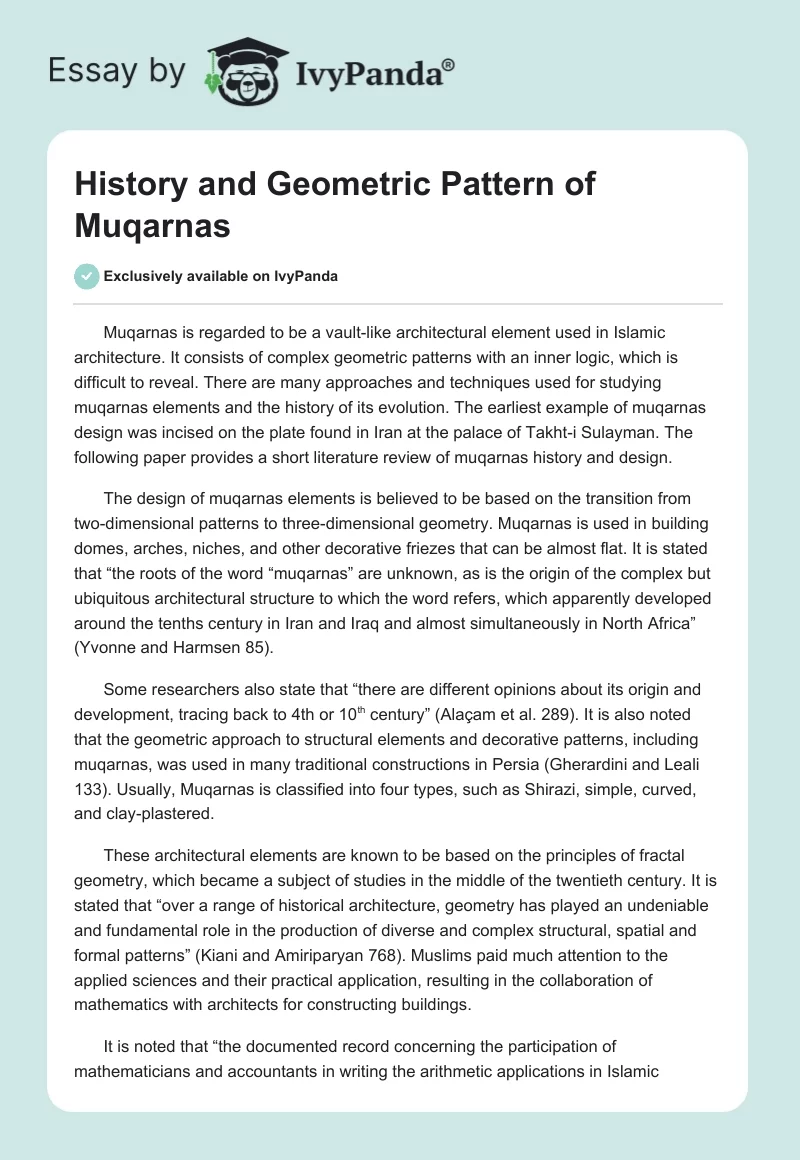Muqarnas is regarded to be a vault-like architectural element used in Islamic architecture. It consists of complex geometric patterns with an inner logic, which is difficult to reveal. There are many approaches and techniques used for studying muqarnas elements and the history of its evolution. The earliest example of muqarnas design was incised on the plate found in Iran at the palace of Takht-i Sulayman. The following paper provides a short literature review of muqarnas history and design.
The design of muqarnas elements is believed to be based on the transition from two-dimensional patterns to three-dimensional geometry. Muqarnas is used in building domes, arches, niches, and other decorative friezes that can be almost flat. It is stated that “the roots of the word “muqarnas” are unknown, as is the origin of the complex but ubiquitous architectural structure to which the word refers, which apparently developed around the tenths century in Iran and Iraq and almost simultaneously in North Africa” (Yvonne and Harmsen 85).
Some researchers also state that “there are different opinions about its origin and development, tracing back to 4th or 10th century” (Alaçam et al. 289). It is also noted that the geometric approach to structural elements and decorative patterns, including muqarnas, was used in many traditional constructions in Persia (Gherardini and Leali 133). Usually, Muqarnas is classified into four types, such as Shirazi, simple, curved, and clay-plastered.
These architectural elements are known to be based on the principles of fractal geometry, which became a subject of studies in the middle of the twentieth century. It is stated that “over a range of historical architecture, geometry has played an undeniable and fundamental role in the production of diverse and complex structural, spatial and formal patterns” (Kiani and Amiriparyan 768). Muslims paid much attention to the applied sciences and their practical application, resulting in the collaboration of mathematics with architects for constructing buildings.
It is noted that “the documented record concerning the participation of mathematicians and accountants in writing the arithmetic applications in Islamic architecture traces back to the 8th and 9th centuries” (Taheri 5). Nowadays, many studies are dedicated to revealing the principles of ancient Arabic architecture to use them for modern constructions.
There are many approaches to understanding the figure shapes of connected elements. Still, many studies are believed to be incorrect in calculations and understanding the principles of construction. For example, in the analysis of a muqarnas dome of the Alhambra, frequency ratios of configurations were calculated, and the researchers came to the conclusion that these ratios are not harmonized with quasiperiodicity (Cromwell 36). Other researchers lack knowledge about muqarnas geometrical patterns as well.
It is a general opinion that the construction of muqarnas initiates with the designing of plain projections, which are simple and symmetrical interlocking patterns consisting of squares, rhombuses, jugs, almonds, and some other geometric figures. The construction is based on the strict rules of geometry and mathematics. Still, the nature of interlocked figure shapes presented at the provided sources, such as the gypsum plate mentioned above, remains unrevealed. It is noted that the 3D formation of muqarnas might give help to decode mathematical principles of muqarnas formation.
A short literature review on muqarnas history and design showed that the technique of its construction is rather ancient and involves complicated mathematical calculations and extensive use of geometry. It is acknowledged that the principles of muqarnas formation remain unrevealed. Nevertheless, modern technology, such as 3D computer design might assist in decoding the puzzle of muqarnas.
Works Cited
Alaçam, Sema, et al. “Reconnoitring Computational Potentials of the Vault-Like Forms: Thinking Aloud on Muqarnas Tectonics.” International Journal of Architectural Computing, vol. 15, no. 4, 2017, pp. 285-303.
Cromwell, Peter R. “Cognitive Bias and Claims of Quasiperiodicity in Traditional Islamic Patterns.” The Mathematical Intelligencer, vol. 37, no. 4, 2015, pp. 30-44.
Gherardini, Francesco, and Francesco Leali. “A Framework for 3D Pattern Analysis and Reconstruction of Persian Architectural Elements.” Nexus Network Journal, vol. 18, no. 1, 2016, pp. 133-167.
Kiani, Zohreh, and Peyman Amiriparyan. “The Structural and Spatial Analysing of Fractal Geometry in Organizing of Iranian Traditional Architecture.” Procedia-Social and Behavioral Sciences, vol. 216, no. 1, 2016, pp. 766-777.
Taheri, Jafar. “Practical Arithmetic in Islamic Architecture: A Critical History and Survey.” International Journal of Architectural Heritage, vol. 11, no. 5, 2017, pp. 747-762.
Yvonne, Dold-Samplonius, and Silvia L. Harmsen. “The Muqarnas Plate Found at Takht -I Sulayman: A New Interpretation.” Muqarnas, vol. 22, no. 1, 2005, pp. 85-94.


